Paddle and Portage—An Atikokan Journey
By Doug Smith
Photographs By Brian Payne
On the remote waterways of a vast Canadian wilderness, a Texas Venturing crew finds adventure, beauty, and stories of grit and determination.
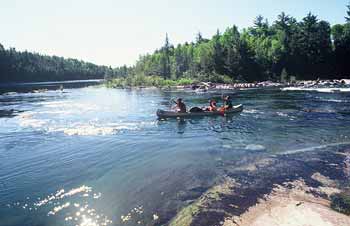 Crew 2031 Venturers Anthony Farrow, J. O. Thomas, and Atikokan staff interpreter Sarah Rowsell head out on the clear Canadian waters of White Otter Lake. |
The wind came out of nowhere, like a howl in the night. Once-calm White Otter Lake—a crystal clear, remote Canadian waterway of bays and islands—suddenly was roiling with white-capped waves.
Sitting in their four canoes, the nine young men and women of Venturing Crew 2031 contemplated options with their leaders while sheltered from the wind behind a small rock island.
"We can turn back and paddle to shore, or we can cross to that island," said Sarah Rowsell, a 20-year-old staff interpreter assigned to the crew. "There's a campsite on the island. Or we can wait here until the wind dies and then paddle at night."
Rowsell and the crew's two adult Advisors were confident the young people in the crew from Canyon, Tex., which is chartered to the First Methodist Church there, had the skills to safely make the quarter-mile crossing. And the youths were game.
So they shoved off and paddled their canoes, loaded with camping gear and food, into the wind and waves. After an exhilarating 20 minutes, they pulled into calm waters, all smiles.
"That was awesome," said Anthony Farrow, 17.
"That was extreme canoeing," agreed Ginny Love, also 17.
It was the kind of challenge the crew anticipated when they planned their nine-day trip through the Canadian wilderness starting from the Donald Rogert Canoe Base near Atikokan, Ontario. It is one of three Northern Tier National High Adventure Bases sites that offer canoe trips for Boy Scouts and Venturers in northern Minnesota and the Canadian provinces of Ontario and Manitoba.
Solitude and raw beauty
For Crew 2031, the windy crossing was one of many experiences shared in a wet and wild landscape far different from their dry, hot Texas home. The vast region of lakes, rivers, and woods stretches from northern Minnesota to northern Canada. It is a mesmerizing place steeped in solitude and raw beauty, a land scoured by glaciers and dotted with boulders and rock outcroppings. It's a place of ancient Indian pictographs, towering pines, and spectacular sunsets.
The group ate freshly caught fish that were fried golden brown, listened to the haunting call of loons at dusk, and inhaled the sweet scent of fallen pine needles baking in the sun.
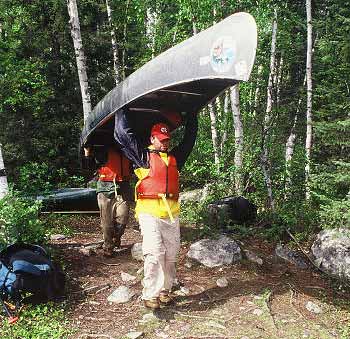
But it's also a challenging place.
There were long days of paddling and portaging—carrying their canoes and heavy packs over rocky trails that link the lakes. There were mosquitoes. And rain, wind, and unseasonably cold temperatures for June.
None of it fazed the Venturers, six boys and three girls from the BSA's Golden Spread Council in Amarillo, Tex.
"It's a good group of kids; they're up for the challenge, and they like to have fun," Sue Doxon said one evening while the group relaxed around a campfire on an island campsite. Doxon and her husband, Chuck, were the crew's two Advisors. Their son, Dan, was one of three Venturers on the trip who was also an Eagle Scout.
During the first three days, the group paddled 50 miles and carried their canoes over one grueling, half-mile muddy portage strewn with fallen trees.
"We had to cut away trees to get through, and we were up to our waist in muck," said Sue Doxon. "They're still laughing, so they must be having fun."
The mosquitoes were a bother on some portages and around camp when the wind died. Several of the girls wore mosquito head nets. Others lathered repellant on their skin.
"I got eaten alive on that long portage," admitted Ginny Love. But the bugs didn't spoil the fun.
"After a couple of days, you barely notice them," said Anthony Farrow, whose brother, Daniel, 15, also was along.
"They're a nuisance but worth putting up with to see this country," said Dan Doxon. "I love paddling."
Captivating experience
The group traversed 30 portages over the nine days and completed their planned 128-mile trip despite being held back by the wind for parts of two days. They paddled 12 hours and scrambled over seven portages in one day to make up lost ground.
They were captivated by the experience.
"We're doing stuff that people back home won't ever do in their lifetimes," said Derrick Roberts, 16, an Eagle Scout who had paddled in canoe country once before.
"You feel you've been successful at something—and we're only in high school. It's pretty cool," he said. "Would I come back? Oh, yeah."
Said Anthony Farrow: "You realize out here what you take for granted back home—like your bed."
"And dry socks," added Ginny Love.
The solitude also impressed the group. "There's not a lot of people out here," Anthony said. "You can really get away from everyone."
For Sara Jimenez, 15, the trip was her first taste of wilderness camping and canoeing. She was smitten.
"If I had known it was this much fun, I'd have been doing it all the time," she said. "I thought it would be harder than this."
Castle in the woods
As with most high adventure trips, there were discoveries and surprises.
After paddling and portaging for half a day, the group slipped their canoes into White Otter Lake, a big waterway that stretches for miles.
Under a cobalt sky dotted with marshmallow-like puffs of clouds, they paddled south down the lake. An incessant wind, gusting to 30 miles per hour, churned White Otter's cold waters into rolling waves topped with whitecaps.
As a bald eagle soared high overhead, the group paddled hard down a bay, then edged into calm waters behind a pine-studded island.
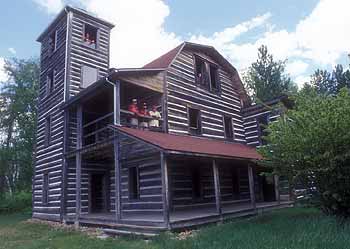 The Venturers tour Jimmy McQuat's White Otter Castle. |
"There's White Otter Castle," Rowsell said, pointing across the bay. "We'll wait it out there and paddle later when the wind dies."
The group could see the red shingles of a building through the pines, but the "castle" itself was hidden by trees.
After securing their canoes on a narrow gravel beach, the group hiked a short distance down the shore. There, in the middle of nowhere, miles from civilization and just 25 steps from the lake, stood White Otter Castle.
"Wow," someone muttered.
The "castle" is a huge three-story log cabin with an impressive four-story tower that offers visitors a tree-top view of the lake. The group stepped inside and soon learned its compelling and heartrending tale.
One man's dream
Jimmy McQuat was a fur trapper, fisherman, prospector, and eventually a hermit. He reportedly was once scolded as a child: "Ye'll never do no good; ye'll die in a shack."
Determined to have a fine house, he slowly built his "castle." Without any help, he cut tall pines nearby, winched them from the woods, hewed them square, and raised them into place with a block and tackle.
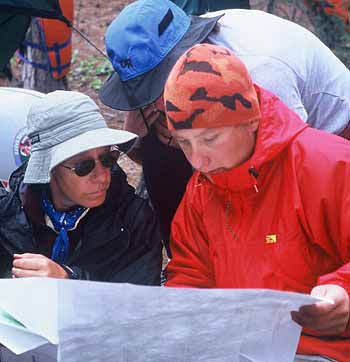 Sue Doxon, Grace Bond, and Dan Doxon study a map to find the take-out for the next portage. |
It was an amazing feat, especially considering Jimmy was just 5 feet 7 inches tall and weighed about 145 pounds. He finally finished the spacious home with its 41-foot tower in 1914.
"Ye couldn't call this a shack, could ye?" he is quoted as saying. "An' I built it all myself."
But Jimmy wouldn't enjoy his spectacular home for long: He drowned while netting fish near his beloved home in 1920. Rangers found his body the following spring and buried him near his castle.
Jimmy's castle fell into disrepair over the years, but it has been carefully restored. Now it is a historic landmark, open for visitors hardy enough to reach its wilderness location.
Jimmy's castle wasn't the only bit of history the group encountered. In the woods north of the castle are the remains of a camp where German prisoners of war logged trees during World War II. And at the headwaters of the lake, an old log sluice recalled the area's rich logging history.
Bound by the wind
With the wind still whipping White Otter Lake into a frenzy, paddling to the crew's intended destination was out of the question. So the group hung out at the castle, cooked dinner in midafternoon, and decided to paddle at night, when the wind usually dies.
While killing time, Rowsell made fresh, deep-fried onion rings. Some of the crew napped, and others pored over maps while resting on the castle's wooden floor. When the wind finally subsided, the group quickly loaded their canoes and pushed off down the bay, only to be ambushed again by more waves and wind.
So they waited on a small island until 9 P.M., when the wind finally let up, then paddled through the wilderness until 12:30 A.M.—an unforgettable night paddle.
"It was awesome," said Sue Doxon. "We just navigated with our compass and map. The water was smooth as glass. It was quite a treat."
During the long drive back to Texas, Dan Doxon used almost the same words to describe his feelings about the trip.
"It was challenging and fun all at the same time," he said. "We had a great time."
Doug Smith also wrote the article about the Trailblazer Adventure Day in this issue.
Plan Your 2005 Northern Tier Trip NowSeven- to 10-day trips at the Northern Tier National High Adventure Bases cost $40 to $44 per person per day. There is a 10 percent discount for crews that begin trips before July 6. Additional fees, such as camping fees, may be required. At Bissett, round-trip floatplane costs will be $130 per person in 2005. It cost Crew 2031 about $600 each, including gas money to and from Texas, for their trip to Atikokan, Ontario. However, each crew member raised about half that amount through money-earning activities. Each crew is assigned a staff interpreter who is trained in wilderness first aid and CPR. Usually a college student, the interpreter aids in waterway navigation and advises the crew in wilderness camping and canoeing skills. He or she also provides historical and naturalist information throughout the trip. Crew 2031 gave the trail food a thumbs-up. Dinners included cheese and potatoes with meatballs, beef Stroganoff, fettuccine Alfredo, and potato casserole. Breakfasts were hot or cold cereal and granola bars. Lunches included pita sandwiches, peanut butter and jelly, and sausage. For desserts and snacks, the crew ate cake, cheesecake, popcorn, muffins, onion rings, and pudding. For more information about the Northern Tier National High Adventure Bases, go to www.ntier.org or call (218) 365-4811. — D.S. |
Atikokan Expands Base Camp for More Scouts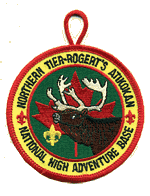
The BSA's Northern Tier National High Adventure Bases comprise three sites — the Charles L. Sommers Canoe Base near Ely, Minn., the Donald Rogert Canoe Base near Atikokan (At-a-coke-cun), Ontario, and Northern Expeditions at Bissett, Manitoba. Each offers Scouts and Venturers a unique adventure. Venturing Crew 2031 from Canyon, Tex., chose the Atikokan base as their launching point. "We have three million acres of wilderness at our doorstep," said Don MacDonald, director of Canadian programs. "This is some of the best flat-water canoeing on the face of the earth. You can paddle for days and not see anyone but the people in your group." And the wilderness stretches far beyond that. "You could start here and paddle to the Arctic Ocean," he said. MacDonald is excited these days. The number of Scouts coming to Atikokan continues to increase. In 1997, just 354 youths went through the base. This year, more than 1,100 will use it. And next year campers will benefit from the base's new 5,500-square-foot permanent building. It will house an enlarged dining hall, kitchen, trading post, and food-packing area. The expansion will allow more Scouts to experience the allure of the North Country canoe wilderness — a place that often stirs the souls of travelers here, compelling them to return. — D.S. |
October 2004 Table of Contents
Copyright © 2004 by the Boy Scouts of America. All rights thereunder reserved; anything appearing in Scouting magazine or on its Web site may not be reprinted either wholly or in part without written permission. Because of freedom given authors, opinions may not reflect official concurrence.